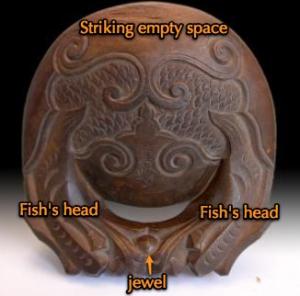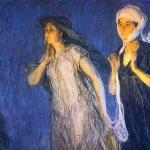
Kuang-hui asked Nan-yuan, “What about before the wooden fish wumps?”
“Looking at the sky, not seeing it,” replied Nan-yuan.
“What about after the wooden fish wumps?” asked Kuang-hui.
“Looking at the ground, not seeing it,” said Nan-yuan.”
Great dharma presentation! “Before” and “after” and even “now” are non locatable. They exist only in words and ideas. What about it? Looking up and down, the wooden fish just goes “wump!”
This kōan is indirectly referenced by Hakuin in Complete Poison Blossoms in a Thicket of Thorn, “47. Instructions to the Assembly Thanking Mr. Noda for Donating a Wooden Fish.” The event prompting the teaching was this Noda-san donating a wooden fish drum, a mokugyō, to Shōinji. Hakuin seizes the day to instruct the monks and thank Noda-san.
In this post, a few points and a couple links.
One striking point, wump #1, is how Hakuin embraced the folksie mythology of his time and peppers it with kōan points. Hakuin begins by telling a fish story about an evil priest who didn’t listen to his teacher (caution!), so was reborn as a fish with a tree growing out of his back (ouch!), but then repents and is transformed (phew!). The former evil priest then donates the wood from the tree that had grown out of his back to the temple. The teacher has it made into the first mokugyo, very literally a fish drum.
Hakuin, in his inimitable style, describes it as as fish with “…two heads with a wonderful gem held between their two mouths; its entire body was like an enormous throat, enabling it to pour forth an endless stream of noxious fumes that spread over vast areas.”
Those noxious fumes, wump #2, accompany our stinky practice and are the barriers to the dharma through which we enter the great way.
Hakuin continues with wump #3, “The wooden fish … its deep voice resonating like heavy thunder … All the ancestors felt its steel fangs and razor teeth.”
This wumping continued through the ages from ancient India through China and Japan. Huineng wrote his poem on the wall while the wooden fish wumped; Shitou sat quietly above the rock while the wooden fish wumped; Juzhi held up one finger while the wooden fish wumped; Dongshan inquired about the true likeness of his teacher while the wooden fish wumped; Rujing hit a sleeping monk with a slipper and Dōgen dropped off bodymind while the wooden fish wumped; Gesshu Sōku was engrossed in mu and the outhouse door blew open while the wooden fish wumped; Hakuin heard the sound of the distant temple bell; and Katagiri Roshi remember how stupid he was while the wooden fish wumped.
In addition, many thousands of others, whose names are left unsung, from all five lines of Zen, from all walks of lives, lived their lives of waking up and living accordingly while the wooden fish wumped. And now that wumping is happening right here.
Certainly, the wooden fish, Hakuin continues, “…kept tune with Zen master Kuang-hui,” the practitioner in the wumping kōan I started this post with, “robbing monks of their knowing and seeing. It blocked off the gates of enlightenment.”
So what about before and after?
“The place of vital importance that is completely untouched by either [before or after]?” said Hakuin, “What is it?”
Yes, it’s gotta be wump #4 – wump, wump, wump, wump.
Hakuin, though, wasn’t done. He wanted to mess with us and have just a bit fun.
“Just now,” he said, “I wrestled this mokugyo to the floor and whispered into its ear, ‘I have a dharani — four five-character lines — that I want to dedicate to valiant Zen students throughout the universe. All who hear it will resolve steadfastly to attain the Way and be blessed with the fortune of life beyond [before and after].”
The Princeton Dictionary of Buddhism, says this about “dharani:”
“In Sanskrit, ‘mnemonic device,’ ‘code.’ The term is derived etymologically from the Sanskrit root √ dhṛ (‘to hold’ or ‘to maintain’), thus suggesting something that supports, holds, or retains; hence, a verbal formula believed to ‘retain’ or ‘encapsulate’ the meaning of lengthier texts and prolix doctrines, thus functioning as a mnemonic device.” And that there are four types: “(1) teachings (DHARMA), (2) meaning (ARTHA), (3) spells (MANTRA), and (4) acquiescence (KṢĀNTI).”
What was Hakuin’s dharani?
Poku, poku, poku, poku, poku.
Poku, poku, poku, poku, poku.
Poku, poku, poku, poku, poku.
Poku, poku, poku, poku, poku.
The translator and annotator, Waddell, notes, “Larger-sized mokugyo make a deep resonant sound — ‘wump, wump” — when struck. Hakuin’s use of the onomatopoeic word “poku” suggests he was beating a smaller variety. The Chinese character for poku can refer to a loud din as well as to the attainment of selflessness.”
In any case, poku or wump, it’s really, “Wump.”
And don’t forget the early nineties deep dharma teaching of Tag Team (thanks, Steve, for this). There it is:
Dōshō Port began practicing Zen in 1977 and now co-teaches with his wife, Tetsugan Zummach Sensei, with the Vine of Obstacles: Online Support for Zen Training, an internet-based Zen community. Dōshō received dharma transmission from Dainin Katagiri Rōshi and inka shōmei from James Myōun Ford Rōshi in the Harada-Yasutani lineage. Dōshō’s translation and commentary on The Record of Empty Hall: One Hundred Classic Koans, is now available (Shambhala). He is also the author of Keep Me In Your Heart a While: The Haunting Zen of Dainin Katagiri. Click here to support the teaching practice of Dōshō Rōshi at Patreon.












